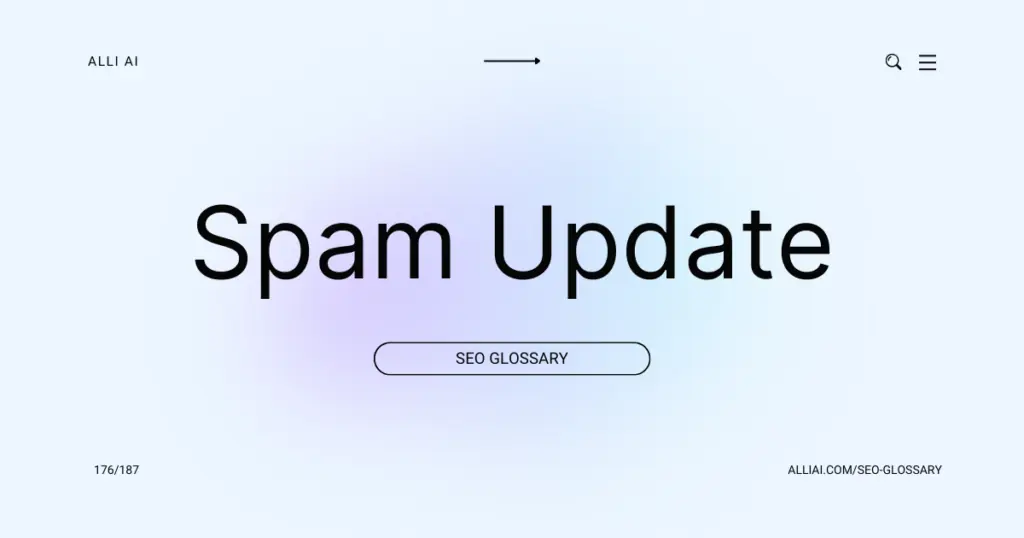What Does Spam Update Mean?
The Spam Update refers to a series of updates by Google aimed at identifying and penalizing websites that employ manipulative tactics to improve their search rankings. These tactics may include keyword stuffing, deceptive redirects, or links from low-quality or irrelevant sites. The update helps ensure that users receive more relevant, high-quality search results by reducing the visibility of spammy content.
Where Does Spam Update Fit Into The Broader SEO Landscape?
The Spam Update, an initiative by Google, specifically targets and penalizes sites that employ manipulative and spammy tactics to improve search rankings. This update reinforces Google’s commitment to rewarding high-quality and user-focused content while penalizing black-hat SEO strategies such as keyword stuffing, cloaking, and using private link networks. The update fits within the broader SEO landscape as an enforcer of Google’s Webmaster Guidelines, ensuring fairness in search results and encouraging SEO practices that enhance user experience rather than exploit search algorithms. Its role is crucial in maintaining a clean, relevant, and trustworthy web environment for both users and marketers.
Real Life Analogies or Metaphors to Explain Spam Update
Imagine the internet as a vast ocean and websites as boats floating on this ocean. A spam update is like the coast guard patrolling the waters, looking for boats that are polluting the sea. These boats are using illegal or harmful methods to navigate faster or appear more prominently than others. When the coast guard finds such a boat, they flag it and can even tow it away to clean up the ocean, ensuring safer and more enjoyable navigation for everyone else.
How the Spam Update Functions or is Implemented?
The Spam Update, initiated by Google, specifically targets and penalizes websites employing spammy practices that violate Google’s Webmaster Guidelines. Here’s how it functions:
1. Detection: The update utilizes Google’s AI and machine learning capabilities to detect spam signals in websites. These signals could be keyword stuffing, cloaking, sneaky redirects, or unnatural links, among others.
2. Assessment: Once spam signals are identified, the system assesses the overall quality of the site and determines the extent of spam tactics being used. This is relative to the site’s content genuineness and usability.
3. Penalization: Sites that are found to be in violation are then subjected to penalties. These penalties can range from a drop in rankings to removal of pages or the entire site from Google’s search index.
4. Notification and Recovery: Webmasters might be notified of these penalties through Google Search Console, where they also receive guidelines on how to rectify the issues. Post-correction, websites can request a review, and if compliant, penalties may be lifted.
5. Continuous Updates: Google continuously refines this update, making it more effective at identifying and penalizing new spam tactics as they evolve. This involves periodic re-assessment and adjustment in response to webmaster feedback and spam trends.
Impact Spam Update has on SEO
Google’s Spam Update targets websites that employ spammy or manipulative tactics to improve their search engine rankings. The impact of this update on a website’s SEO performance and rankings is significant if the site engages in practices that violate Google’s guidelines. Websites found using such tactics can experience a sudden drop in their search rankings, effectively reducing their visibility on search engine results pages (SERPs). For users, this update improves the experience by filtering out low-quality, spammy content, ensuring that higher-quality, relevant, and trustworthy websites are more prominently featured. Websites that adhere to ethical SEO practices and focus on providing genuine value to users are typically rewarded with better rankings and more stable performance in the search results.
SEO Best Practices For Spam Update
1. Analyze your website’s content to ensure that it doesn’t contain spammy elements such as keyword stuffing, hidden text, or misleading redirects.
2. Regularly revise content to remove any auto-generated content that does not provide value to users.
3. Check for the presence of any aggressive monetization practices including excessive ads or affiliate links that degrade user experience.
4. Utilize tools like Google Search Console to monitor and review any spam messages or manual actions; address notifications promptly.
5. Improve user engagement signals by enhancing the user interface and providing valuable, unique content that encourages longer site visits and interactions.
6. Implement security measures, such as secure protocols (HTTPS) and regular scans for malware, to protect your site from hacks and secure user data.
7. Review and refine your backlink profile by removing or disavowing links that come from low-quality or irrelevant sites to avoid penalties related to unnatural linking patterns.
8. Ensure all user-generated content (like comments or forum posts) is moderated for spam and low-quality contributions.
9. Use structured data and meta tags responsibly, without attempting to manipulate Google’s crawlers by misleading content or structured data spam.
10. Regularly update and audit your SEO strategy based on the latest spam guidelines and algorithm updates issued by search engines.
Common Mistakes To Avoid
1. Keyword Stuffing: Overusing keywords can make your content unreadable and signal search engines that your focus is manipulation rather than providing quality content. Instead, use keywords naturally within the context.
2. Cloaking: Showing different content to search engines than you show to human users is deceptive and heavily penalized. Ensure all users see the same content.
3. Sneaky Redirects: Redirecting users to a different URL than the one they initially clicked is misleading and can cause trust issues. Use redirects honestly to guide users during site restructuring without tricking them.
4. Link Schemes: Purchasing links, excessive link exchanges, or using automated programs to create links to your site can all negatively impact your site’s ranking. Focus on building natural links by creating valuable content.
5. Automated Content: Using bots or programs to generate content can lead to low-quality or irrelevant content. Always ensure content is human-generated and offers real value to readers.
6. Hidden Text and Links: Hiding text or links (such as white text on a white background) to manipulate rankings is deceptive. Keep all text and links visible and relevant to users.
7. Article Spinning: Rewriting existing content to appear original is often poorly executed, resulting in low-quality content. Always create original, high-quality content.
8. Irrelevant Keywords: Adding popular but irrelevant keywords to increase traffic disregards user experience. Make sure all keywords are directly relevant to your content.
9. Excessive Tagging: Overusing H1 tags or other headings within a piece of content doesn’t lead to better SEO, but instead can lead to a spammy appearance. Use headings appropriately to structure articles.
10. Misleading Structured Data: Incorrect use of structured data to deceive search engines and improve SERP with rich snippets can lead to penalties. Always use structured data that accurately represents your page content.






